Judging bagels in the company of Sarit Packer and Itamar Srulovich of Honey & Co, and Poopa Dweck, a Jewish food writer from New Jersey, in front of an expectant kippah-clad audience, is – as I discovered recently at Gefiltefest, London's annual Jewish food festival – a nerve-wracking experience.
Bagels are in fact an eastern European import to the States and a recent trip to New York reminded me just how good they can be. A real bagel, that is, not the shiny bread rolls with a hole in the middle that pass for bagels in the UK. OK, the ones we were tasting, from London's Jewish bakeries, were decent, but if your postcode doesn't start with NW, frankly you don't have a hope of scoring a fresh one. Unless you're prepared to roll up your sleeves and bake them yourself, that is. (Note: this recipe is for the smaller, chewier form of bagel that pre-dates the fluffy behemoths more popular today.)
The flour and ratios
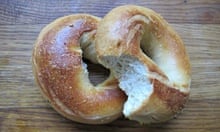
Most bagel recipes call for strong bread flour; the US Cook's Illustrated New Best Recipe book explains that the higher protein content will prompt more gluten formation in the dough – and also helps give the bagel its characteristic chewy texture. It reasoned, however, "that an even higher-protein flour would rise better, yielding a bagel that was plumper and had a finer, chewier texture".
I couldn't find high-gluten flour on British shelves, but very strong flour is available in supermarkets, and this does help with the texture – the closest I come without it is Richard Bertinet's recipe in Crust, which has a decent chewiness to it, though not quite as much as the Cook's Illustrated recipe, or that from Baron Baking in Oakland, which also uses very strong flour. If you can't find any, don't despair, but it is certainly worth the hunt. (To any east-coasters scoffing at the idea of a decent bagel in California, baker Dan Graf, a native New Jerseyite, has devoted some serious time to recreating the bagels of his childhood in the Oakland sun.)
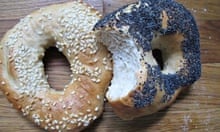
Bagel dough is stiffer than the average bread variety, because it contains less water; Harold McGee writes in McGee on Food and Cooking that "a standard bread dough has 65 parts water to 100 parts flour; bagel dough has only 45 or 50". This makes it hard to work with (Cook's Illustrated specifically advises against attempting to knead it by hand), but is essential for the texture – Ruth Joseph's recipe, in her Warm Bagels and Apple Strudel book, has a water-to-flour ratio of 62 to 100, and consequently, her bagels, though delicious, are far more bready than the chewy versions from Cook's Illustrated (50:100), Bertinet (46:100) and Baron Baking (53:100). And, whatever those New Yorkers claim, their water has nothing particularly special about it. Joseph also uses a mixture of wholemeal and white flour, but for me, as an occasional treat, bagels should be white – the wholemeal kind just doesn't taste right.
Fats and sugars
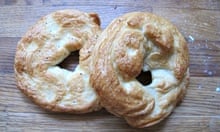
Claudia Roden writes in her Book of Jewish Food that "when I phoned around for tips to improve my bagels, I found that most people now use an egg in the dough, which makes the bread lighter, softer and less chewy than the traditional version". She's right, so I'm going to leave it out of my recipe. Roden and Joseph both add oil to their doughs, which also has a softening effect – but I will keep the fat for the topping.
Sugars, however, have a vital role to play in the perfect bagel. Bertinet uses honey, Joseph soft light-brown sugar, Roden sugar, Cook's Illustrated malt syrup, and Baron Baking diastatic malt powder, which I have to order online. In addition to providing flavour, these also help to give the bagel its shiny brown crust (the "diastatic" bit of the malt refers to enzymes that help break down the flour's starch into sugars to feed the yeast, and is often used to help give a better rise without adding sugar, but it doesn't make too much difference here). Honey will do at a pinch, but I think the malty flavour of the syrup makes it worth seeking out; most health food shops will stock it, if you don't have any left over from that malt loaf.
The fermentation
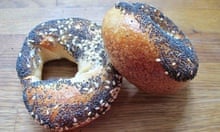
Baker Peter Reinhart, a name that comes up a lot in the course of my bagel research, says that baking good bagels "is all about long, slow, cold fermentation ... The secret ingredient is time. Any decent bagel shop knows this and uses an overnight method to stretch out the fermentation." Almost all my recipes call for this overnight step, with Bertinet adding an overnight-fermented dough starter to his other ingredients, Joseph resting the dough overnight, and Cook's Illustrated and Baron Baking shaping the dough before proving in the fridge. Only Roden goes for a more standard three-hour rise and prove process, and, if I'm honest, her bagels taste a bit boring in comparison. I mean, they're fine – they're Claudia Roden's bagels, but I don't get the feeling they're really her bag.
So far, bagel making has been surprisingly straightforward – in fact, the only hard bit is the shaping. Initially, I'm fully behind the Bertinet method, where he uses the end of a rolling pin to punch a hole in a ball of dough, rather than rolling it out into a sausage, and sticking the two ends together, that everyone else recommends – with softer, springier dough, it's hard to get it to stay together. I don't master the process until I read the Baron Baking instructions about shaping it round your hand (it's important to make the hole disproportionately large, as Joseph explains, otherwise it will close up); I find it quicker than the Bertinet way, but if you can't get the hang of it, poke your holes instead.
The cooking

Bagels need boiling – Reinhart writes that a "number of bagel companies now skip the boiling (really, more like poaching) and use steam-injected ovens, but this produces a kind of a hybrid bagel/French-bread texture". Boiling sets the crust, so it will remain hard and chewy, but too long a boiling time (2-3 minutes on each side from Joseph, but 1-2 minutes from Roden) will make the crust too hard, and stop the inside from expanding as it should.
Lots of recipes add malt syrup or baking powder to the water – extra syrup makes no difference to the colour of the crust. The baking powder is supposed to give the crust shine, but if you're after that, you may as well brush them with beaten egg, as Joseph and Roden suggest. Personally, I think they're handsome enough without. Once boiled, they should be well drained, dipped in any toppings you might fancy and then baked in a really hot oven – a good tip from Baron Baking: "If you have a baking stone or brick you use for baking, put it on a rack near the bottom of the oven; it will retain heat and produce a crisper bagel."
Turning them over once during cooking gives them a nice all-round tan. Allow them to cool before ripping into them, but don't leave it too long; bagels are at their best within a few hours. After that, you're better off toasting them – they'll still be delicious.
The perfect bagels
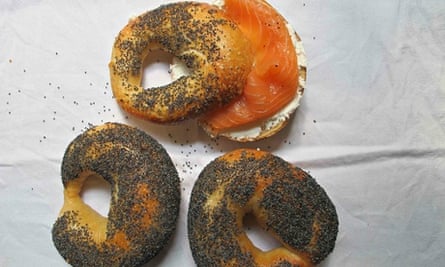
(Makes about 12)
1 tsp dried active yeast
3 heaped tsp malt syrup
375ml lukewarm water
750g high-protein or high-gluten flour (or strong bread flour)
2 tsp salt
50g poppy or sesame seeds (optional)
Put the yeast in a bowl, then stir 1 tsp malt syrup into the water to dissolve and add to the bowl. Whisk together, cover with a tea towel and leave until the surface is covered with froth. Stir in the remaining malt syrup.
Put the flour and salt into a stand mixer if you have one, add the yeast mixture and mix with a dough hook on the lowest speed for about 5 minutes until it comes together into a dough. If doing it by hand, mix until it starts to come together, then turn on to a clean work surface (no need to flour), and work and knead the dough until smooth, bearing in mind it will be very stiff. Cover and leave in a warm place for 2 to 2.5 hours or until about doubled in size.
Line 2 baking sheets with lightly greased baking parchment. Turn the dough out on to a clean work surface and punch the air out of it. Divide into balls weighing about 85g each.
Roll each ball into a sausage about 20cm long. Wrap it round your knuckles, with your hand flat and the two ends flapping at the palm side. Pinch them together, then roll your hand along the work surface to seal. Place on the baking sheet and repeat. Cover each sheet well with cling film and place in the fridge as soon as it's full. Refrigerate between 18 and 24 hours, then remove from the fridge about half an hour before cooking.
Bring a large pot of water to the boil and add a generous amount of salt. Heat the oven to 240C (220C fan) and put a baking stone in there, if you have one. Put a cooling rack near the hob and tip the seeds, if using, into a bowl just slightly larger than the bagels.
Add as many bagels as will fit comfortably in one layer to the pan (don't be tempted to overcrowd them). Boil for 30 seconds, then flip over and boil for another 30 seconds. Drain on the rack and repeat.
Dunk each bagel into the seeds, if using, then put seed-side down on the baking trays. Bake for 7 minutes, then flip over and bake for another 7 minutes or until golden. Cool on the racks.
Bagels: is there anything to compare with the New York version and how do you like to eat them? The traditional American lox and cream cheese (a combination said to have been popularised by the Philadelphia cheese company in the 1950s), banana and peanut butter, or (heresy) bacon and egg?

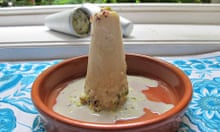
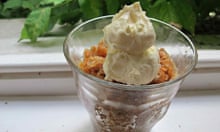

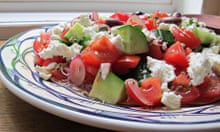
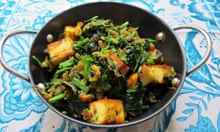
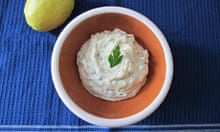
Comments (…)
Sign in or create your Guardian account to join the discussion